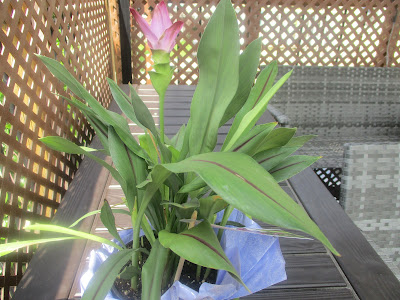We'd set aside two pairs of khaki jeans that Irving had bought on sale at half price a few months back. They were still in the bag they had come in, lying on a shelf at the bottom of the double-glazed buffet in the breakfast room next to my sewing basket, and more or less forgotten, as a chore that could wait. But Irving hauled them out this morning, cut the bottoms of the legs to his proper size/height and pinned up the hem of one of the pair. Then he began shortening them. Not the first time he has hemmed a pair of his trousers, and it always makes me uncomfortable.
I was busy cleaning the bathroom and powder room. By the time he was finished, I was too, and we gathered ourselves for a walk in the ravine. Before that, we had ample time to spend in the backyard with Jackie and Jillie, looking about and admiring the garden phlox in bloom. While we were out food shopping yesterday, there was a plant at, of all places Farm Boy, that caught my eye. I'd never heard of it before, and intrigued by the emerging flower, brought it home. Called a Curcuma, a member of the ginger family, it's really a Turmeric plant. I can hardly wait to see its entire flowering.
The plant is from Asia, like so many of the plants we enjoy and admire in our gardens, where in our northern climate, they're seen as annuals. They cannot survive our winters, since they're essentially warm-weather plants that require damp soils. But they bring joy to our eyes with the diversity of their shapes, the beauty of their petals and their rich colours.
Of course there are wild counterparts, as well, intrusive foreign species that do adapt well to our climate, and they're considered pests. Like the beautiful Himalayan orchids that reseed themselves endlessly in the forest, like the purple loosestrife that at one time caused an uproar of warning that it would displace native species and take over completely...and never did.
Of course there are also vegetation species that are interlopers that can cause medical problems if they're encountered in the wild; take for example Wild Parsnip that really is establishing itself throughout some areas of the forest, capable of causing severe skin irritation on contact. So we learn to avoid their presence. Taking precautionary measures becomes part of the natural environment risk we take willingly; like identifying poison ivy and staying well clear of it.
We decided we'd have barbecued hamburgers and corn for dinner tonight. I used lean ground beef and prepared it with egg, breadcrumbs, spices and made use of a hamburger press Irving had brought home years ago. One smaller hamburger will be used to supplement a few meals on top of kibble, for Jackie and Jillie. They'll be pleased about that.
When we returned from our ravine hike, it was the turn of the garden at the front of the house to take our attention. It's hard to believe at this time of year that the bold colours, the architecture of the garden trees, shrubs and hardscape that Irving built decades ago, will be entirely hidden for five months of the year, with winter's arrival. Just an indication of how resilient and fecund nature is in the garden's ability to restore itself from April to October.
Once we made our way back into the house, Jackie and Jillie nudged me to pay attention as they waited, not the least bit patiently, for their afternoon vegetable salad. It's gone in a snap, once the cucumbers, bell peppers and tomatoes have been cut into bite-sized pieces for them. And then I turned my attention to sewing up the second pair of trousers that Irving meant to do tomorrow, as he protested vigorously. I know he's capable of doing it himself, as he says, but it just doesn't feel right to me. In any event, he still had to thread the needles for me for as long as it took to do the job!








No comments:
Post a Comment